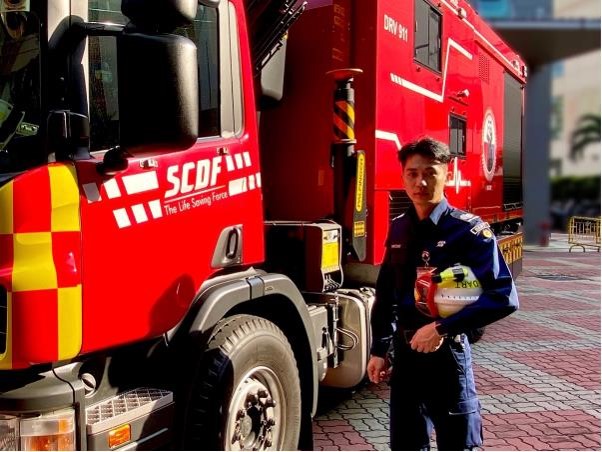The ringing of aft bells from SCDF’s vessels and the final water salute marked the end of service for the Force’s two longest-serving vessels, the Marine Fire Vessels (MFVs) dubbed Firefighter I and Firefighter II.
The two MFVs, formerly known as Api Api 1 and Api Api 2, had operated under the ownership of the Maritime and Port Authority of Singapore (MPA) until 2012 when they were transferred to SCDF. They were refurbished and renamed as Firefighter I and Firefighter II in 2013. Since then, the vessels have been deployed in numerous firefighting and rescue operations of the Life Saving Force.
 Api Api 2 (as it was named then) in action
Api Api 2 (as it was named then) in action
 Firefighter I and Firefighter II
Firefighter I and Firefighter II
The MFVs had shown their prowess during major exercises like Exercise Highcrest, led by the Republic of Singapore Navy, and Exercise Ferex, led by MPA, which underscored their importance in safeguarding Singapore waters.
“When we first took over the marine firefighting function from the MPA on 1 April 2012, the two MFVs were all that we had of a nascent capability entrusted with the heavy responsibility to protect our port,” remarked Assistant Commissioner (AC) Derek Tan, the first commander of the SCDF Marine Division from 2011 to 2020.
AC Derek continued, “I’m sad to bid the old Firefighters farewell but also happy that we have already put in place a fleet of newer and more capable vessels to continue keeping our port safe and secure for years to come.”
 The blue ensign flag was lowered from each MFV to mark the end of its service to SCDF.
The blue ensign flag was lowered from each MFV to mark the end of its service to SCDF.
The decommissioning and departure of the MFVs on 4 August 2021 left many fond memories within SCDF, especially to the crew of the SCDF Marine Division.
Among the crew who had journeyed with the MFVs were Deputy Rota Commanders of Brani Marine Fire Station, Lieutenant (LTA) Mohammad Naizal Bin Md Rasid and Second Warrant Officer (WO2) Noh Ridzuan Bin Khosnen.
 LTA Mohammad Naizal Bin Md Rasid
LTA Mohammad Naizal Bin Md Rasid
"When I first helmed the MFV, it was overwhelming and I felt really small behind the steering wheel. Eventually, I became more familiar with the vessel and gained greater confidence as a steersman. I would say that I grew up with the MFVs. There is this unbreakable bond we had for many years,” said LTA Naizal, a veteran of SCDF for close to two decades.
“I remember how newly appointed steersmen like us back then were trained with the MFVs such as sailing 24-hour during exercises. That was challenging as our physical and mental toughness were put to the test, especially when sailing at night where visibility was low. It was in these vessels that I developed resilience and confidence as a steersman,” recalled WO2 Ridzuan who has served in the Life Saving Force for over a decade.
 WO2 Noh Ridzuan Bin Khosnen
WO2 Noh Ridzuan Bin Khosnen
On 13 September 2013, LTA Naizal and WO2 Ridzuan attended a major fire incident involving an Anchor Handling Vessel, Lanpan 26. There were explosions from Lanpan 26 and its engine room was on fire. Together with other firefighters, LTA Naizal and WO2 Ridzuan helmed Firefighter I and fought the blazing inferno.
“Most, if not all of us, were recalled back to base to support the firefighting operation that night. For young mariners like me back then, operating in unchartered waters during this incident was challenging but we eventually brought the fire under control with a well-thought strategy,” recalled WO2 Ridzuan.
According to WO2 Ridzuan, layouts of buildings in Singapore such as warehouses and HDB flats tend to be generally similar to one another. With familiarity of these layouts, firefighters typically know how to manoeuvre so that the fire can be put under control in the shortest possible time.
On the other hand, the complex interior of vessels can be very challenging for firefighters at sea. Moreover, the immense heat coming from the vessels’ metallic interior adds to the challenge. Strategising is therefore of paramount importance in putting out such fires.
“The incident involving Lanpan 26 was most memorable for me because I remember having to flank the fire from the port side using the limited resources that were available to us then. Despite the uncertainty of the burning vessel’s interior layout, we successfully contained the fire by quickly thinking on our feet and adapting to the situation,” LTA Naizal recalled.
 Personnel from the Marine Division bidding farewell to the MFVs in a farewell water salute
Personnel from the Marine Division bidding farewell to the MFVs in a farewell water salute
During a farewell water salute, as the MFVs sailed under the water curtain and moving away into the distance, Marine Division’s personnel bade the vessels farewell, acknowledging the end of their tow. When asked what he missed most about the MFVs, WO2 Ridzuan said, “There was a time when the MFVs meant everything to us. And what made the vessels truly effective were the teams of dedicated and skilled operators and specialists.”
“We can’t stop changes from happening and changes are always for the better, especially in SCDF,” LTA Naizal added.
“The future of Marine Division looks promising as we embark onto the trial of unmanned technologies such as the Unmanned Aerial Vehicle and the Unmanned Surface Vessel,” said Colonel (COL) Ryan Ong, Commander of Marine Division. “The use of such unmanned technologies in our operations would greatly enhance safety and efficiency, and at the same time ensures operational effectiveness. We are also working on the expansion of our fleet to further enhance the safety within Singapore waters.”






